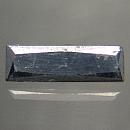|
Click on a letter above to view the list of gems. |
|
|
|
|
|
|
|
|
Stibnite
|
|
| | |
| Discovered in 1832; IMA status: Valid (pre-IMA; Grandfathered) | ||
|
| ||
|
Chemistry |
|
|
| |
|
Sb2S3 | |
|
|
Antimony Sulfide |
|
Molecular Weight: |
339.70 gm |
|
Composition: |
Antimony |
71.68 % |
Sb |
|
|
|
|
Sulfur |
28.32 % |
S |
|
|
|
|
|
100.00 % |
|
|
|
|
|
|
||||
|
Classification |
|
|
| |
|
Sulfides | |
|
2/D.08-20 | |
|
|
2 : SULFIDES and SULFOSALTS (sulfides, selenides,
tellurides; arsenides, antimonides, bismuthides; sulfarsenites,
sulfantimonites, sulfbismuthites, etc.) |
|
Related to: |
Stibnite Group. Dimorphous with Metastibnite. Forms a series with Bismuthinite. |
|
Varieties: |
Selenian Stibnite |
|
Synonyms: |
Alcohol, Antimony Glance, Grey Antimony, Lupus Metallorum, Platyophthalmite, Spiessglas, Stibi, Stimmi |
|
|
|
|
Crystal Data |
|
|
|
|
|
Slender to stout, complexly terminated crystals, elongated along [001], to 0.65 m; bent crystals not uncommon, rarely twisted. In radiating and confused groups of acicular crystals; also columnar, granular, or very fine masses. |
|
|
Rare; twin planes {130}, {120}, and perhaps {310} |
|
|
|
|
|
Physical Properties |
|
|
|
|
|
Perfect and easy on {010}; imperfect on {100} and {110} |
|
|
Sub-Conchoidal |
|
|
Highly flexible but not elastic; slightly sectile |
|
|
2.0 |
|
|
4.63 (g/cm3) |
|
|
Non-fluorescent |
|
|
Not Radioactive |
|
|
Other: |
Melts at 546°C |
|
|
|
|
Optical Properties |
|
|
|
|
|
Lead-Gray, tarnishing Blackish or Iridescent; in polished section, White |
|
|
Opaque |
|
|
Metallic, splendent on cleavage surfaces |
|
|
R1–R2: (400) 31.1–53,3, (420) 30.8–53.2, (440) 30.6–53.0, (460) 30.7–52.8, (480) 31.0–52.2, (500) 31.2–51.1, (520) 31.4–49.7, (540) 31.2–48.5, (560) 30.8–47.2, (580) 30.3–45.8, (600) 29.7–44.5, (620) 29.3–43.5, (640) 29.2–42.6, (660) 29.4–41.8, (680) 29.6–41.1, (700) 29.4–40.3 |
|
|
0.00 |
|
|
Strong; Color in reflected light: White |
|
|
|
|
|
Occurances |
|
|
|
|
|
Geological Setting: |
Of hydrothermal origin, formed in veins through a wide range of temperatures. |
|
Common Associations: |
Realgar, Orpiment, Cinnabar, Galena, Lead Sulfantimonides, Pyrite, Marcasite, Arsenopyrite, Cervantite, Stibiconite, Calcite, Ankerite, Barite, Chalcedonic Quartz. |
|
Type Locality: |
Ichinokawa, Shikoku, Japan |
|
Year Discovered: |
1832 |
|
View mineral photos: | |
|
|
|
|
More Information |
|
|
|
|
|
| |
|
|
|
|
The
following localities have produced outstanding crystallized
material. In the USA, at the White Caps mine, Manhattan
district, Nye County, and the Murray mine, Independence
Mountains district, Elko County, Nevada. From the San
José and other mines, Oruro, Bolivia. In Germany, at
Wolfsberg, Harz Mountains, and near Arnsberg, North
Rhine-Westphalia. At Kremnica (Kremnitz) and Banská
Štiavnica (Schemnitz), Slovakia. From Príbram, Czech
Republic. At Baia Sprie (Felsöbánya) and Herja (Kisbánya),
Baia Mare (Nagybánya) district, Romania. In France,
at Massaic, Cantal; and at La Lucette, Mayenne. At the
Kusa mine, near Bau, Sarawak, Malaysia. From Thames,
New Zealand. At Bahar-Lou, near Hamadan, Iran. From
Kadamzhay, Kyrgyzstan. Magnificent groups of crystals
in the Ichinokawa mine, near Saijo, Ehime Prefecture
(Iyo Province), Japan. In China, from the Xikuangshan
mine, northeast of Lengshuijiang, Hunan Province and
the Lijai Valligy mine, Lushi, Henan Province. |
|
|
We
have not photographed our Stibnite gems. Please
check back soon. |
